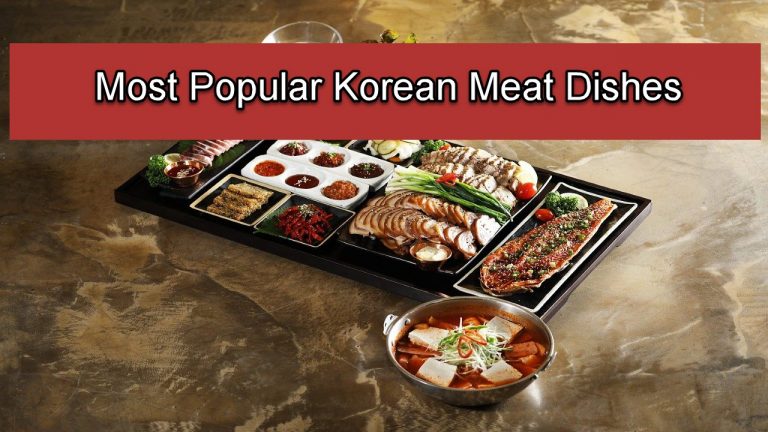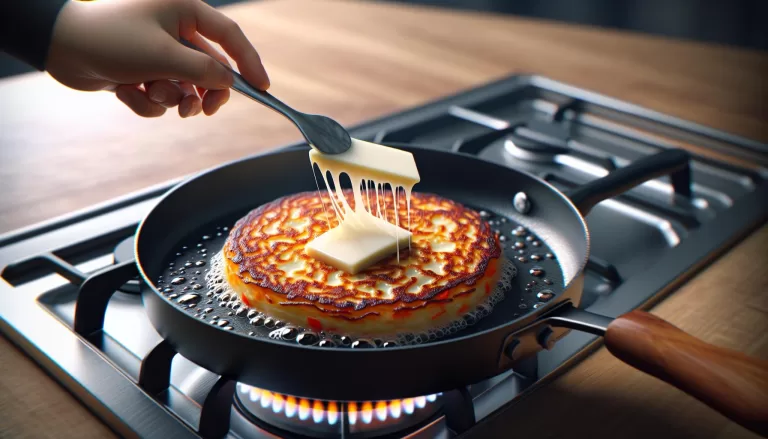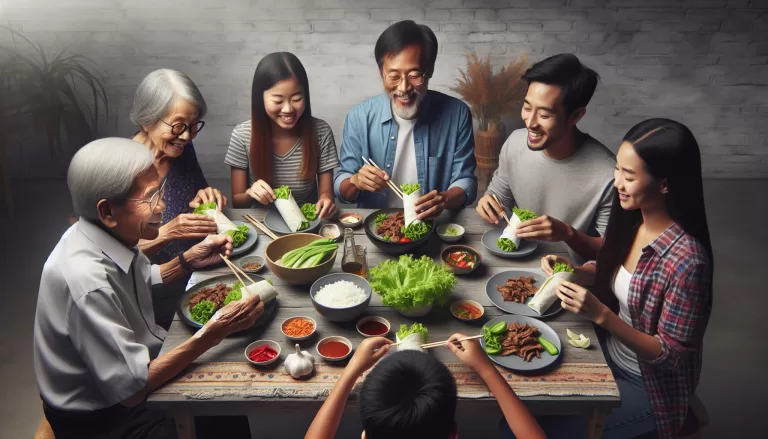Easy Step by Step Guide to a Delicious Homemade Japchae Korean Stir Fried Starch Recipe

History of Japchae
Japchae has a rich and fascinating history. First conceived during the Joseon Dynasty, it became a royal banquet staple. Yet today, you’ll find it at family dinners, celebrations, and even casual lunch boxes. Let’s dive into that history and unearth the story behind these flavorful noodles.
Japchae was first cooked for King Gwanghaegun in the 17th century by one of his royal chefs. The dish, bursting with colors and flavors, was an immediate hit! It won the King’s heart so much that he promoted the chef to a high-ranking official.
Originally, Japchae was a luxury dish due to the high cost of its ingredients. Things like noodles, beef, and vegetables were hard to come by, making Japchae a meal only the elite could enjoy. It’s unsurprising, then, this dish became a mainstay at royal banquets and special events.
Over time, Korea underwent several economic transitions. By the 20th century, as ingredients became increasingly accessible, Japchae transitioned from a royal banquet dish to a popular everyday meal. It’s served now at family gatherings, potlucks, and it’s a crucial element in holiday feast tables.
The recipe has evolved significantly as well. Early iterations of Japchae didn’t even include noodles! It was a simple mix of stir-fried vegetables. Noodles, meat, and the signature seasoning were added later when these ingredients became widely available.
Ingredients for Homemade Japchae

With a dish as diverse as Japchae, it’s no surprise that the ingredient list can be quite long. But don’t worry, preparation is half this delightful stir-fry dish journey, and the result is more than worth the effort.
So, ready to roll up your sleeves and start? Let’s look at your shopping list.
Firstly, you’ll need 150g of dangmyeon, also known as Korean sweet potato starch noodles. Its unique texture makes it a standout element in many Korean dishes. In case you find it challenging to locate these, vermicelli noodles serve as a good substitute.
Next comes meat and veggies. A good mix for this recipe includes 300g of beef, thinly sliced, and vegetables such as 1 medium-sized onion, 2 medium-sized carrots, 1 large bell pepper, 2 medium-sized zucchini, and 2 large handfuls of fresh spinach.
Once your noodles, meat, and veggies are sorted, it’s time to get those flavor-infusing ingredients. For that authentic Japchae punch, you’ll require 4 cloves of garlic, finely minced, 100ml of soy sauce, 50ml of sesame oil, 2 tablespoons of sugar, and sesame seeds for sprinkle.
Let’s bring in that unique twist. A pinch of chili flakes can be an exceptional addition to add a mild kick to the dish and take your Japchae to the next level. Not something you see in every recipe, but certainly something that would appeal to those who appreciate a gentle heat in their meals.
Regarding the nutritional value of Homemade Japchae, it’s a wholesome, filling dish packed with healthy fiber, protein, and multiple vitamins. Here are the nutritional values per serving:
| Nutritional Element | Quantity |
|---|---|
| Calories | 250 kcal |
| Carbohydrates | 40g |
| Protein | 12g |
| Fat | 7g |
| Fiber | 6g |
| Sugar | 6g |
Step-by-Step Cooking Instructions

When we consider the bold flavors and nutritional value inherent in Japchae, it’s worth the effort to master this dish at home. Following a proper blueprint makes the job easier.
Start with boiling the Korean sweet potato starch noodles. When they’re soft and chewy, drain them and set them aside.
While the noodles simmer, prime your wok, or a large skillet if a wok’s not handy, over medium heat with some sesame oil. Throw in some garlic and bathe your kitchen in that intoxicating smell.
When the garlic’s turned golden, bring in the vegetables. In true Korean tradition, stir fry the veggies lightly for a crunchy delight. If you’re experimenting though, adding a bit of red wine could give a surprising twist to this authentic dish.
To this colorful mix, put in your boiled noodles, just ripe for the taking. Add soy sauce for an umami blast or miso paste if you desire an earthier feel. Give it a healthy stir making sure each noodle’s coated and glistening.
Remember those chili flakes you wondered about? Now’s the perfect time to invite them to the party. A pinch can heighten the flavors, but who’s stopping you from turning up the heat?
If you’re a protein enthusiast, this is where you add thinly sliced beef or chicken. Give it a thorough stir until they’re just cooked. For our vegetarian friends, tofu or portobello mushrooms can make an incredible stand-in.
Lastly, don’t forget a light sprinkle of toasted sesame seeds before you serve, adding both a nutty flavor and an Instagrammable touch. There you have it – your homemade Japchae, ready to impress.
By developing a feel for the ingredients and their interaction, you’ll master the Japchae stir fry. Meanwhile, enjoy the journey, making this staple Korean dish your own. The fun lies not just in consuming the final product, but in crafting your unique Japchae experience. Effortlessly, you’ve taken a classic to new heights. Your version, your rules. Enjoy.
Tips for Perfecting Your Japchae

Cooking Japchae is an art, and as with any art, it benefits from a few helpful hints. Here, we explore some tips and tricks that will assist you in creating a Japchae dish that’s as unique as it is delicious.
Mind the Noodles
The heart of any Japchae dish lies in its noodles. Korean sweet potato starch noodles, also known as “glass noodles”, are what give Japchae its distinct texture and taste. Don’t rush the boiling process. It’s crucial to boil these noodles until they’re translucent and chewy, marking the perfect texture.
Variety is Key
Don’t be afraid to experiment with your choice of vegetables and proteins. Whether you prefer beef, chicken, tofu, or mushrooms, you’re in luck. Japchae embraces them all. You could consider alternatives like shrimp or even a vegan option like seitan. Remember to cut your ingredients into thin, uniform strips for a consistent cooking time and texture.
Spice it Up
While the standard seasonings of soy sauce, sesame oil, and sugar are essential, don’t hesitate to step out of the box. Got a liking for red wine or miso paste? Throw it into the mix. Customizing your Japchae to your taste preferences can make the dish truly your own.
Pack a Nutritional Punch
Your personalized Japchae isn’t just about flavor. It can be a nutritious meal that packs a punch. Here is a brief rundown of the nutritional information for a standard Japchae recipe:
| Nutrition | Amount |
|---|---|
| Calories | 280 kcal |
| Protein | 8 g |
| Fats | 1 g |
| Carbohydrates | 60 g |
Take the chance to boost your vitamin intake. Most commonly used veggies in Japchae are rich in vitamins A, B, C, and E.
At the end of the day, crafting a perfect Japchae is about letting your culinary creativity shine. Enjoy the process. After all, it’s a journey: a journey that leads you, bite by delicious bite, into the heart of traditional Korean cuisine.
Serving and Enjoying Your Homemade Japchae

The moment has come. You’ve prepared your stir-fry, made your seasoning just right, and it’s time to serve your homemade Japchae. The best thing? It’s just how you like it… perfectly customized to your taste buds.
First, start by placing the warm, flavorful Japchae onto a wide, shallow bowl or plate. This allows your dish to breathe, maximizing the blend of flavors in every bite. Try using traditional Korean earthenware for an authentic look and feel.
Second, how about garnishing your dish for added color and depth? A sprinkle of sesame seeds, some chopped spring onions, or even thin red pepper strips can not only beautify the plate but also enhance flavors. Remember, visual appeal impacts taste perception, so take the time to make your dish look irresistible!
Pairing wine with Japchae syncs beautifully. A delicate yet crisp white wine, such as a Pinot Grigio or a Riesling, complements the savory noodles and subtle sweetness in the dish. If you’re more of a tea person, a hot steaming cup of traditional Korean plum tea will make the experience complete.
Let’s talk nutrition. The diverse set of ingredients in Japchae cater to a wide range of nutritional needs. Here’s a quick overview:
| Ingredients | Calories | Protein | Carbs | Fat |
|---|---|---|---|---|
| Sweet potato noodles | 90 per half cup | 0g | 22g | 0g |
| Stir-fry Veggies | Varies | Varies | Varies | Varies |
| Protein (Shrimp/Seitan) | Varies | Varies | Varies | Varies |
As apparent, your recipe’s nutritional value could vary based on the proteins and veggies you use. However, sweet potato noodles remain a low-fat and high-carb cornerstone of the dish, serving up key energy without the added guilt.
Here’s something important: turn your smartphone off, pull up a chair, and revel in your culinary masterpiece. Enjoy your meal slowly, savoring every bite. You’ve just cooked a perfect, personalized version of a traditional Korean delicacy. So, dig in and let your taste buds celebrate.
Conclusion
So, you’ve journeyed through the process of making your own Japchae at home. It’s a testament to your culinary prowess, a showcase of your ability to blend flavors and textures into a dish that’s both pleasing to the palate and the eye. You’ve discovered the nutritional benefits of sweet potato noodles and learned how to perfectly pair your Japchae with white wine or Korean plum tea. Now, it’s time to savor the fruits of your labor. Enjoy the meal you’ve crafted, taking pride in your personalized rendition of this traditional Korean stir-fry. After all, every bite of your Japchae is a bite of your own culinary masterpiece. So, here’s to your success in the kitchen and many more delicious meals to come!





